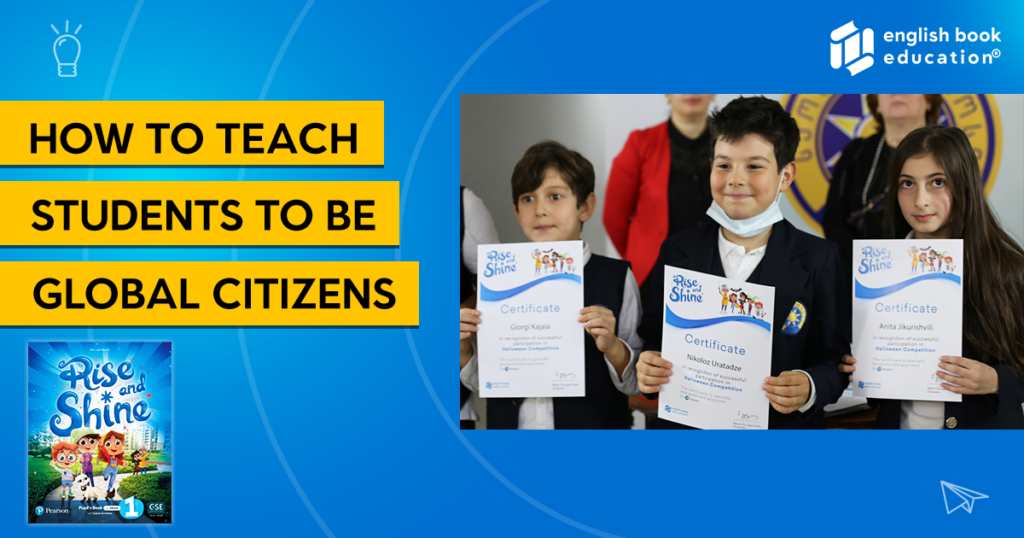
As teachers, we all want our students to work toward making the world a better place. And through focusing on global citizenship, this drive to change the world is something we can help foster every day in the classroom. In this post, we’ll explore how:
What are global citizens?
A global citizen is someone who knows that they are part of a worldwide community. They understand there are people who have completely different lifestyles, appearances, cultures and routines, but with whom we share common values and responsibilities. Global citizenship encourages tolerance and understanding – and learning about it helps children to become open-minded adults.
Within the context of a primary English classroom, helping students become aware of themselves as citizens of the world will be an introduction to a global way of thinking. And we can do this while also helping them to become familiar with – and proficient – in English.
How can we introduce the concept?
Before students put themselves in a global context, they should get to know themselves as individuals. But they should also get to know themselves as people who are part of their immediate communities.
In the classroom this can be done by encouraging students to think about something personal, such as their likes and dislikes. We can then encourage students to look a little further: what kinds of home do they see in their communities? What makes a house a home to them? What about people working in their communities – what important jobs do they do, and how do they make an impact?
For language teachers, the idea is to combine vocabulary and grammar structures with a slowly widening view of our world. Simply by introducing the concept that we are part of a worldwide community can take the children out of their own experiences, and help them start to consider others.
Tips & activities:
Social media makes it possible for teachers to get in contact with each other across borders, and to set up a collaboration between their schools. Something simple, like organizing a class video call for students after lunchtime and encouraging students in different countries to discuss what they ate in english, can help learners become more globally aware.
How can we teach students to be proactive?
Once students know something, they can progress to putting their knowledge into action. Teachers can foster this by encouraging good habits – a simple example is how we teach very young children to throw their litter in a bin. As they grow older, we can ‘unpack’ these habits. That is, we can help children look deeper into why they’re so important. Using the example of litter again, this could mean making students aware about how their civic responsibility has a real environmental impact.
Let’s look at how we can go from knowing to doing, in simple stages, with a range of topics that are common in the language classroom:
Food:
- Ask students to think about what they like and dislike.
- Ask students to name foods that are good for us and what we should eat more of.
- Teach about school lunches in other countries.
- Teach about dishes eaten on special occasions around the world.
- Have a food festival or ‘munch day’ where students make snacks from around the world.
Buildings:
- Ask students to talk about their own homes.
- Teach about types of home in other countries.
- Discuss eco-architecture – such as solar panels, living walls, wind turbines on roofs and local material that might be used in building processes.
- Venture outside as a class to plant potted flowers and improve the school yard, or make a container to collect rainwater for the school garden.
Jobs:
- Teach about the jobs people do at school –such as cleaning, cooking, or driving.
- Think about jobs within the community and why they are necessary.
- Think about what skills each child and their parents have, and how these skills needed for different jobs.
- Have a skill sharing day where students teach each other something new.
- Host a ‘kids take over day’ where students get to do an important job at school (such as cleaning the classrooms or serving lunch).
Technology:
- Discuss the different types of technology used at home and school.
- Think about how to use this technology responsibly.
- Talk about different households and find out how and when tablets, laptops and phones are used. For example, who is allowed to watch videos while eating? Who can read on their tablet in bed?
- Make your own set of technology rules for the classroom, and discuss why they’re important.
Holidays:
- Ask students what they like to do on holiday.
- Teach about how to stay safe at the ocean or in the countryside.
- Talk about other countries students have travelled to, or would like to travel to, and learn about interesting landmarks in those countries.
- Discuss eco-tourism efforts and why they are important.
- Have a ‘Let’s go to [name of a city or country) day.’ Make posters about famous sights, learn some phrases of the language spoken there and have students imagine they have gone abroad for the day.
Rise and Shine is a 7-level story-based primary course that combines language learning with global citizenship. It is built on the Global Scale of English, which helps students to understand exactly what they are learning and why.

Rise and Shine is a 7-level story-based primary course that combines language learning with global citizenship. It is built on the Global Scale of English, which helps students to understand exactly what they are learning and why.
The course inspires learners to become confident explorers – they learn English and aim to become responsible global citizens. The series is also designed for use in inclusive and mixed-ability classrooms and supports every learner to achieve and shine.
Source: Pearson
 Blog EBE English Book Education
Blog EBE English Book Education



